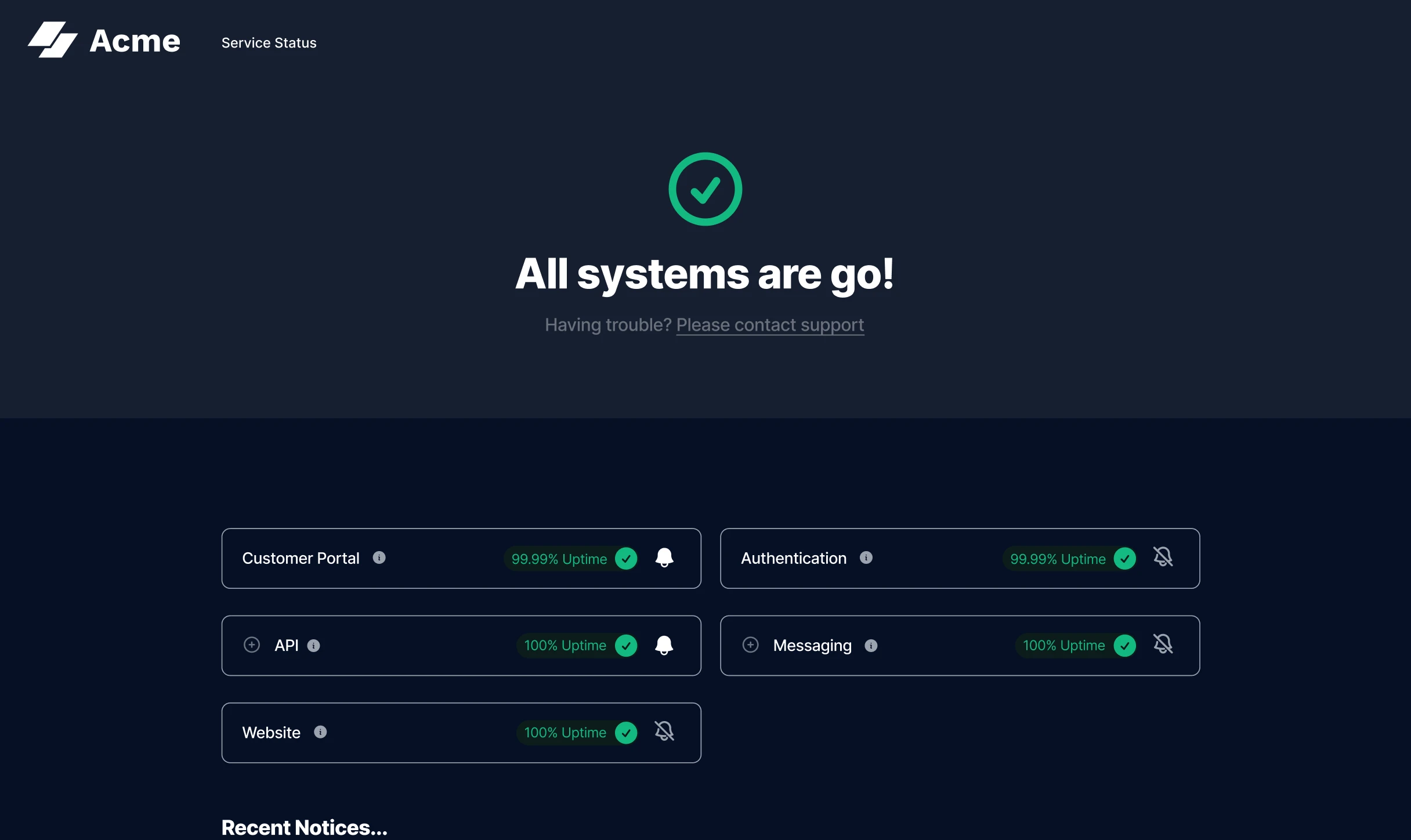Post-incident reviews: improving team performance and customer confidence
 Jake Bartlett · 9-minute read
Jake Bartlett · 9-minute read
When an incident is finally over, it’s hard to be excited about looking back on it. Let’s face it: incidents aren’t your proudest moment and they can be stressful. A simple mistake might lead to all-hands-on-deck, late-night troubleshooting, and upset customers. Incidents weigh on you.
During an incident, all we want is for the incident to be resolved and for us to go back to normal work. But not so quick! Post-incident reviews are a critical part of the incident response process, and this is where the real trust-building starts with customers.
Properly run post-incident reviews can transform your product and your team, shaping a culture of accountability, learning, and continuous improvement. The result? A more reliable platform and a team your customers can trust.
In this article, we’ll explore what a post-incident review (PIR) is, when and why you should conduct one, and how a solid PIR process can build trust with customers.
What is a post-incident review?
A post-incident review (PIR) is the process of understanding what happened, why it happened, and how it was resolved. The end goal of a PIR is to learn, improve, and reduce the chances of the same incident happening again.
Historically, PIRs were referred to as “postmortems”. However, over the last decade, many incident teams have moved away from using the term postmortem, which can imply failure and death, and instead prefer terms like post-incident review or retrospective. These alternatives emphasize learning, improvement, and team collaboration.
A post-incident review typically includes a timeline of events, root cause analysis, lessons learned, and clearly defined action items, and it can involve everyone from SRE, engineering, Ops, customer support, and anyone else who was impacted or has insights to contribute.
A PIR is a process that typically results in a document, and it may include a meeting as part of that process. Let’s break it down:
- PIR as a process: A structured look back at an incident to understand what happened, why, and how to prevent it from happening again. It involves gathering timelines, facts, and insights from people involved.
- PIR as a document: The formal written report that captures findings from the PIR process. A public PIR usually includes an incident summary, timeline, contributing factors, impact, and root cause. An internal version of a PIR might also include what went well, what didn’t go well, and action items for the team.
- PIR as a meeting: A collaborative session with key stakeholders to review the incident and discuss insights. This meeting can be a critical part of the learning process and helps align people on the next steps.
It's worth noting that not every incident needs a post-incident review, and not every PIR needs a meeting or a public write-up. For smaller issues, a quick internal note may be enough. And in many cases, teams run PIRs asynchronously, especially when working across time zones. The key is having a process that matches the scale and impact of the incident.
How your team conducts a PIR and whether you choose to share a PIR document with customers is really up to you. We’ll share some best practices on this later in this article, but the most important thing to do is to consider customer impact as well as their expectations.
Why it’s easy to skip a post-incident review
Some incidents might not need a full-blown PIR. On the other hand, sometimes skipping a PIR can be a big mistake, especially if the impact is high and customers expect it.
Here are some common reasons teams choose to skip a PIR:
It’s tempting to move on
There are always competing priorities and other fires to be fighting. Many teams deprioritize post-incident reviews for the sake of staying on course, hitting deadlines, and maintaining development velocity. They think, “The incident is over, let’s just move on”.
Mindset shift: Taking the time to conduct a PIR can actually save you time in the long run. By identifying critical areas for improvement, you can reduce the chances of the incident recurring.
They require a lot of resources
Pulling multiple people away from their priorities to conduct a PIR is costly. Think about it: you’ve got a couple of SREs, an engineering lead, a support lead, and maybe a product manager all spending an hour or more to create a PIR. That could ultimately cost the company thousands of dollars.
Mindset shift: Invest in the PIR now to save money down the road. When done well, a post-incident review will have a lasting impact and help your team and product become stronger.
A fear of blame
If the team culture isn’t blameless, people may avoid PIRs to dodge uncomfortable decisions and awkward conversations.
Mindset shift: Avoid finger-pointing. Build a blameless incident management culture to foster a safe space where productive conversations can happen. This ultimately unites the team and creates stronger relationships.
No clear owner or process
Many teams skip the post-incident review process because they haven’t defined a process or owner. If it’s nobody’s job to lead the PIR, then it’s likely to fall through the cracks.
Mindset shift: Define which team or role is responsible for conducting a post-incident review and create a standardized process for when and how you do PIRs.
Not seeing the value
If past PIRs have felt like box-ticking exercises with no follow-up, teams won’t be motivated to do them again. If this is the case, you might need to refine your process for reviewing incidents, ensuring you run them for the right incidents and always have follow-up action items.
Mindset shift: Consider why your previous PIRs didn’t feel useful. Define a clear decision framework for why, when, and how you conduct post-incident reviews moving forward.
How post-incident reviews build customer trust
When something goes wrong, customers don’t just want to know you fixed it; they want to know what you learned from it. PIRs force you to look deeper and signal to customers that your team takes incidents seriously, values transparency, and is committed to improving over time.
Shows accountability
PIRs give customers confidence that you’re doing the hard work, and you’re following through to improve their experience in the future. They show customers you’re not hiding behind vague explanations or blaming external factors. Instead, you’re owning the issue, analyzing it, and sharing outcomes.
Increases transparency
When key learnings are shared with customers, it tells them you’re not afraid to pull back the curtains and give them an inside look into what went wrong. Showing them exactly what happened and what’s being done to prevent a repeat incident is a true commitment to transparency, which builds trust.
Shows commitment to improvement
A public PIR process signals that your team doesn’t just fix problems reactively, you invest in systems, training, and processes to get better over time. This proactive approach builds confidence that future incidents will be handled even more effectively.
Faster future response
The more you learn from past issues, the better you get at spotting patterns and resolving incidents faster in the future. Whether it’s product issues you uncover or internal processes that need to be ironed out, identifying them during a PIR is key. This turns each incident into an opportunity to strengthen both your product and your response strategy.
Improves internal collaboration
Post-incident reviews foster a culture of shared learning and open communication, which directly impacts the quality and speed of everything behind the scenes, including relationships between colleagues. As internal collaboration improves, those connections trickle down into other areas of the business, including customer support.
What warrants a PIR?
Whether you run a post-incident review depends on a lot of factors. Each team, product, and customer base is unique. However, here are some general rules when you should consider conducting a PIR:
- Duration: The incident lasted longer than expected or beyond the SLA
- Severity: It caused significant user impact
- Change impact: It triggered significant changes to infrastructure, process, or policy
- Recurrence risk: There is a chance this could happen again without deeper investigation
- Customer concern: Many customers reached out in frustration or confusion
- Cross-team involvement: Multiple teams or tools got involved.
- Public visibility: The incident was discussed publicly (e.g., Twitter, Reddit, etc.)
- Security breach: The incident involved data being compromised or personal information being leaked.
When should you share a PIR with customers?
Not every incident needs a public post-incident review, but when the impact is high, customers will want answers. If the incident caused extended downtime, data issues, or required major changes to prevent recurrence, it’s a good idea to publish a post-incident review.
As Nic Coates, Customer Experience Manager at Sorry™, shared from his time at Broadcom:
“I was pretty rigorous with requesting post-incident reviews from providers we used. It was important for us to understand what was being done to mitigate future issues.”
That said, there’s a balance to strike. Rushing the post-incident review process can result in missed details or insights, while a delayed one may cause customers to lose confidence. The goal isn’t speed, it’s clarity. Take the time to conduct a thorough investigation and analysis. Just don’t leave your customers in the dark during that process.
As you work through the PIR, your status page is your ally. Use it to share follow-up updates, let users know a review is in progress, and set expectations for when more information will be available.
Customers understand that incidents happen. What matters is how you communicate during and after, and whether you show you’re learning from it.
PIR best practices
Here are some quick tips for running successful post-incident reviews:
- Capture key details during the incident: A good PIR starts with a solid incident response process. Assign a scribe to log key actions as they happen, so you’re not relying on memory later.
- Get it on the calendar ASAP: Act quickly. Context fades fast, and so can customer trust.
- Include all involved internal stakeholders: Cross-functional input gives a fuller picture.
- Gather all relevant data: Timelines, logs, communication threads, and screenshots all help reconstruct the incident clearly.
- Focus on facts, not blame: A blameless environment encourages honesty and deeper insights.
- Document everything: Write a clear summary so others can learn from it later.
- Identify follow-up tasks: Improvements don’t happen unless next steps are clear and owned.
- Ask the right questions: Capture what worked and what didn’t so you can repeat what served your team well, and avoid what didn’t.
- Keep the PIR actionable: Avoid vague lessons and instead, tie learnings to specific changes or decisions.
- Close the loop: Follow up on action items and communicate outcomes internally (and externally when appropriate).
- Look for patterns: Over time, PIRs can reveal recurring issues that signal deeper system flaws.
A post-incident review template
If you're new to PIRs or looking to improve the information you gather, start with our simple template below:
A brief, descriptive title (e.g., “Login Failures for EU Users”)
Incident start and resolution timestamps
A short, plain-language explanation of what happened and its impact.
Timestamps and brief descriptions of key moments throughout the incident.
Who was affected? What functions or services were impacted? For how long?
What ultimately caused the incident? Include any contributing factors or systems involved.
What was done to resolve the issue? Any temporary or emergency fixes?
What changes are being made to prevent recurrence? Who is responsible, and what are the timelines?
How many support tickets were received about the incident?
Link to a status page incident update (if public) and a summary of how the issue was communicated to users.
What went well? What could have gone better? Where did we get lucky?
PIR examples
Let’s look at some examples of post-incident reviews shared publicly by some notable companies.
Example 1: Crowdstrike
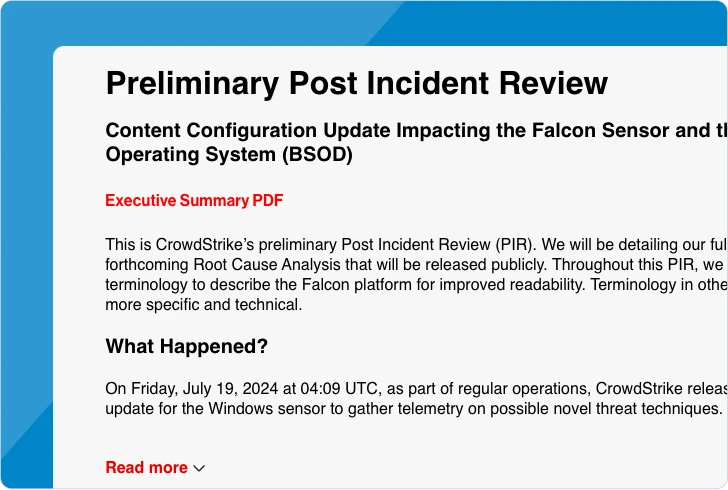
What they did well: Crowdstrikes famous 2024 outage rocked the world. But they did a great job providing a high level of detail and technical information. Their PIR leaves little room for follow up questions.
View the full Crowd Strike PIR
Example 2: Docker

What they did well: Docker’s PIR is very well written. Their introduction quickly explains what happened and why.
Example 3: Linear
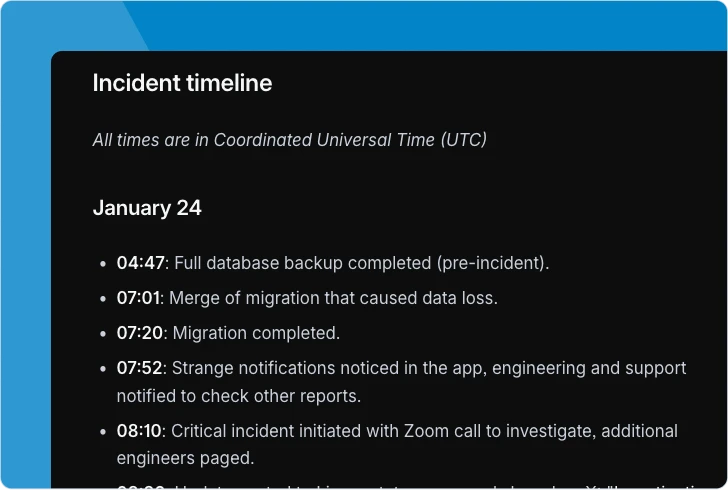
What they did well: Linear provided a detailed timeline of events, which is a key component of a good post-incident review.
Creating a post-incident review in Sorry™
Sorry™ makes it easy to share post-incident reviews with customers. When you’re ready to share your PIR, simply head over to the incident and write a new update:
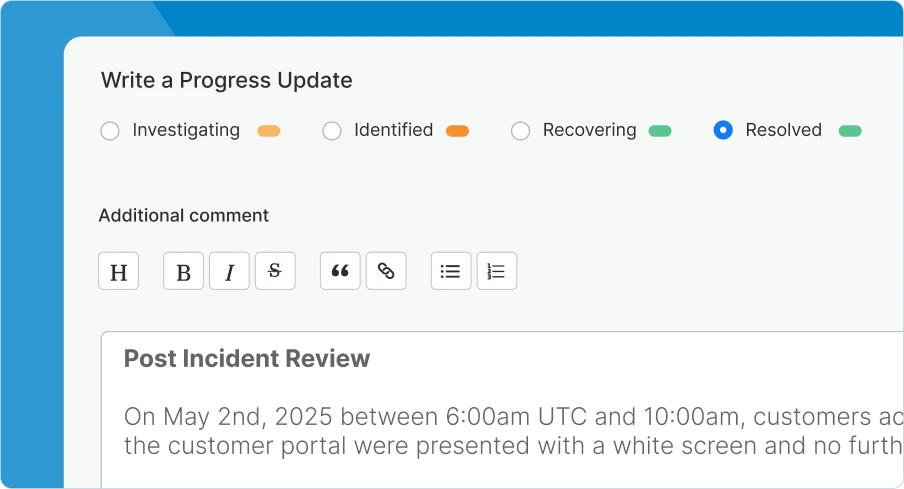
You can format your post-incident review using our WYSIWYG. Here’s an example of a PIR we shared recently:
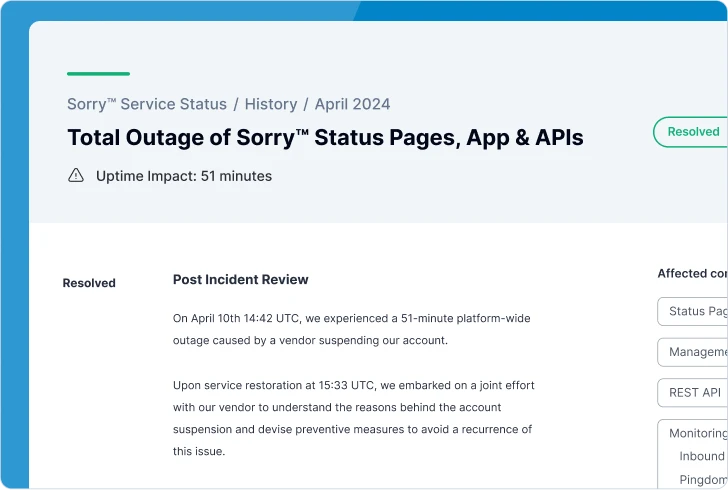
Trust comes from clear communication
Customers don’t expect perfection, but they do expect honesty and improvement. Post-incident reviews give you a chance to communicate clearly, take ownership, and show you’re learning from what went wrong.
Are you looking for an easy way to share post-incident reviews with your customers? Start a free trial of Sorry™ today!
Interested in improving your incident communication process?
We provide the easiest status page tool for handling incident communication through multiple channels.
